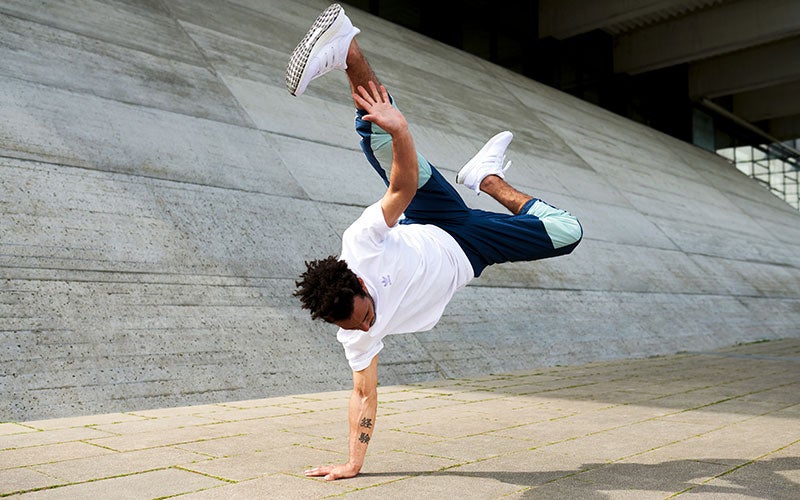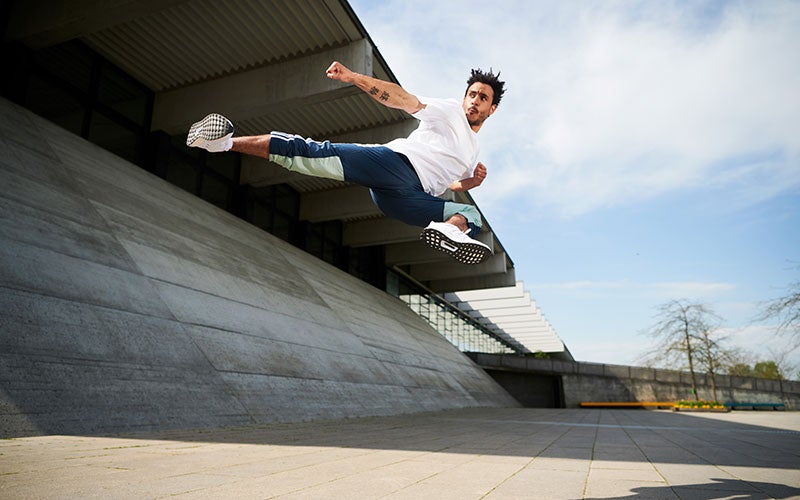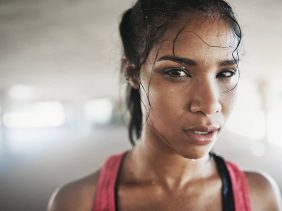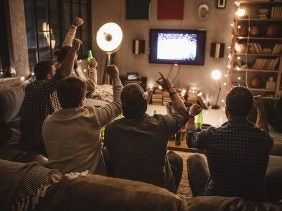Movement becomes art – Interview with movement artist Malik
 ©foodspring
©foodspring
Malik (Instagram: malikk.davis) is a movement artist. Whether he’s at the park next door or performing in Cirque du Soleil in Las Vegas, Malik amazes everyone. It’s not only because of his mastery of his own body, fitness, and grace; his story is fascinating, too. Get inspired, read on:
Getting to know you!
What…
…makes you laugh the most?
My own ridiculousness, probably.
…are the words you live by?
Be true to yourself and regret nothing.
Which…
…kitchen gadget do you use every day?
Definitely my electric kettle. What can I say? I love tea.
…unwritten rule would you add to the book if you could?
Never work out without warming up.
…song goes in every playlist you make?
Riders on the Storm by The Doors fits in nearly everywhere and anytime.
…foodspring product would you be, and why?
Tough call. I think the Muscle Pack Small and I have a few things in common.
Introduce yourself in a different way: If you were a book, what would the summary on your back cover be?
Good and evil, black and white, highs and lows: our lives are based on these sorts of opposites. “Malik” immerses the reader in a world of endless parallels and the bridges that connect them.
You describe yourself as a movement artist. What can we expect from your work, and how did you get into this field?
I perform using a wide range of movement styles, like martial arts tricking, capoeira, dance, and dance acrobatics. Movement is part of my nature. I’ve always been very athletic and I’ve loved the challenges. And then it came to a point where I had to make a decision: use my potential to the fullest, or spend my life doing something that I have absolutely no connection to.
How do sports affect your mood? What does movement mean for you?
Most of the time, a session gives me the good feeling that I’ve accomplished something. But sometimes, I find I’m not happy with one or two of my movements, and that gets me into a funk. Movement, to me, means development, art, passion, communication, physics, and the ability to adapt yourself to physical situations. That helps us to develop our bodies further.
What does a day in your life look like (routines, workouts, meals, etc)?
After I wake up, I take the time to stretch really well. If I have any problem zones, including some that might have come up the night before, I spend some extra time on them with a 15- to 30-minute strength program. Then I hop into the shower and get myself some breakfast. I might have a big bowl of plain, full-fat yogurt with popped spelt, blueberries, raisins, and flax seeds with a big cup of Indian chai.
When I’ve filled up my water bottle and brought my bike out of the garage, I’m out of the door and working on my to-dos and appointments. I don’t often eat lunch, but I might have a wrap with halloumi and vegetables from my favorite restaurant, Sahara.
In the afternoon it’s time to train. I spend two to three hours working consciously on my body, refining my techniques, or challenging my limits. Finally I hop onto my bike, rush home, and get myself into the shower so I can finally stretch out. Done!
By that point, I’m done with the world. I drag myself to the kitchen and I might warm myself up some leftover chicken and vegetable curry with rice. While I eat, I spend a few moments analyzing that day’s movement training, which I’ve recorded on my phone. And finally, I unwind with a mini ice cream bar and a film.

Where do you want to go? Who do you want to be? Belonging is an issue that drives all of us: we all want to belong somewhere, to something. Is there a sense of belonging in the movement scene, even though it’s an individual sport?
To be quite honest, I’m really happy here in Berlin. I have friends, family, and coworkers who bring flavor to my life. It would be amazing to have the financial freedom and the opportunity to travel when and where I wanted. As for who I want to be? Someone who goes through life with a good conscience, and not tell any lies about myself. To me, belonging isn’t really that important. I might just be blessed to have the diverse group of friends I do – maybe that blinds me to other options. When I make the decision to do something, it’s not because I want to belong to that community; it’s because I’m really fascinated by the topic. Tricking, for example, has a small and close-knit community. When I work on my tricking, we’re all giving each other tips and tricks, making fun of each other or celebrating each other’s achievements when someone learns something new. So it’s really not all that individual of a sport!
What makes your community special?
It’s just like any other urban sport: tolerance, openness, and sticking together.
Even though you’re doing an individual sport – how did you manage to keep your sense of belonging in the last year, without losing your motivation? Do you have any tips for us?
Who said I kept the same motivation levels up? With Covid out there, all the sports halls have closed down, which has absolutely made my training situation harder. So what I ended up doing was using my time in a different way and making the best of it. My tip would be to turn it into a kind of assignment, and to find a workout partner. It’s a lot harder to find the drive to get yourself moving if you’re only doing it for yourself.
What do you think makes a strong team?
Finding and making the best of everyone’s individual strengths and weaknesses. Trusting each other.
What was the biggest challenge for you when you started with this sport? What’s your personal goal?
Without a doubt, it was about loosening up my body and getting flexible. 10 years of being a sprinter did a real number on shortening my tendons. And when you’re working in a sport that’s all about performing clean and technical moves, you have to be able to maximize your movements and do them as big as you can. As for my goal? I’m in the middle of redefining it. The year before last, I made it to Vegas with Cirque du Soleil, which had been my goal for ages. Now Covid has more or less killed the performance industry, so I’m considering reorienting myself.
If I were on the hunt for a new sport and came across the movement artist scene, how would I get started? And what tips would you give me, or any beginner?
The title of “movement artist” just means that you’re an artist who has chosen movement as their form of art. Start online: check out YouTube or Instagram and have a look at all the kinds of movement styles. Some of the biggest keywords are martial arts tricking, freerunning, contemporary dance, capoeira, and so on.
And once you’ve found a style you love, have a google to see if there are any clubs or training spots nearby. Alternatively, try gyms that offer free training, which is a great starting point to get into the communities and find out more about them. My biggest tip for free training? Don’t ever be afraid to ask how to do one of the moves you see. Most athletes are happy to be able to pass on their knowledge. And subconsciously, as they think over it, it might lead them to a new flash of inspiration. Win-win, everyone’s happy.
If you want to come along for more of Malik’s journey, check out his social media channel!
Sources for this article
We at foodspring use only high-quality sources, including peer-reviewed studies, to support the facts within our articles. Read our editorial policy to learn more about how we fact-check and keep our content accurate, reliable, and trustworthy.
































